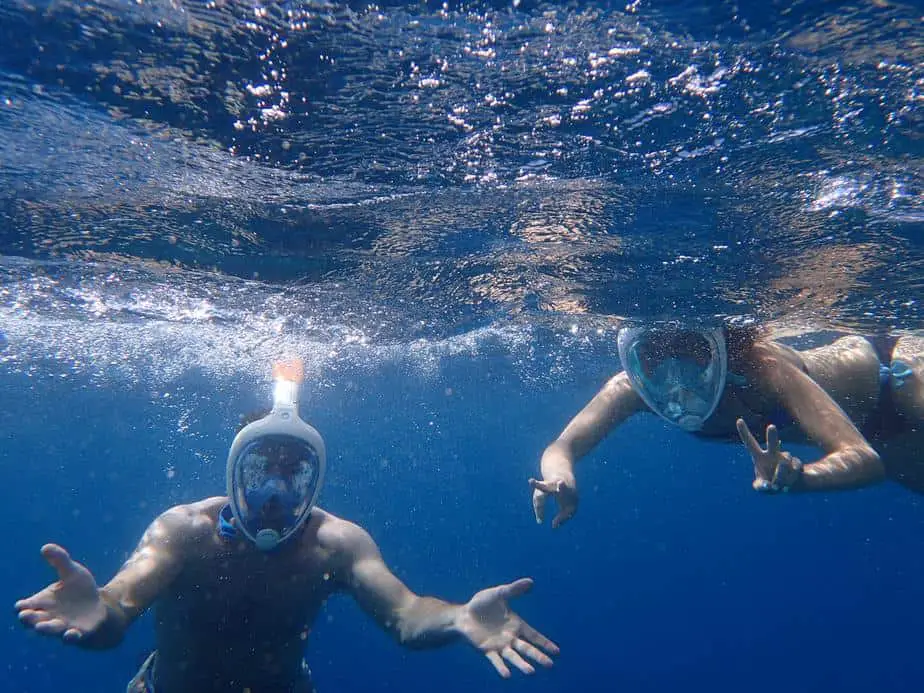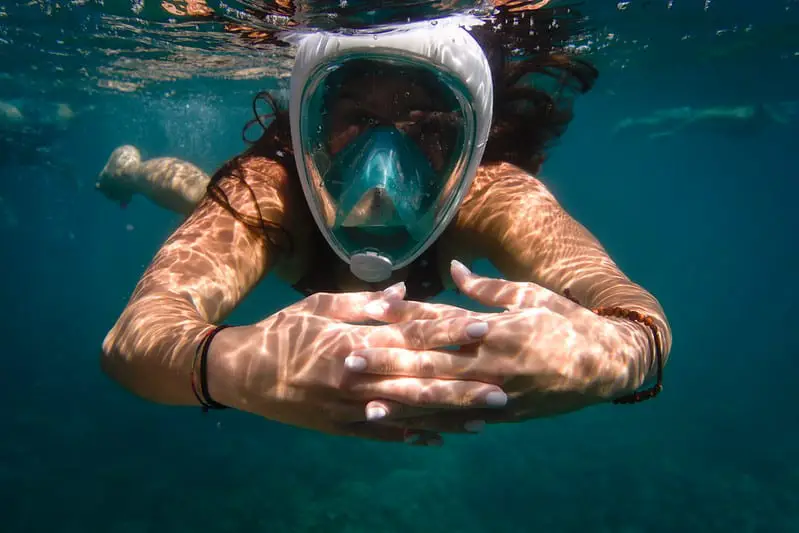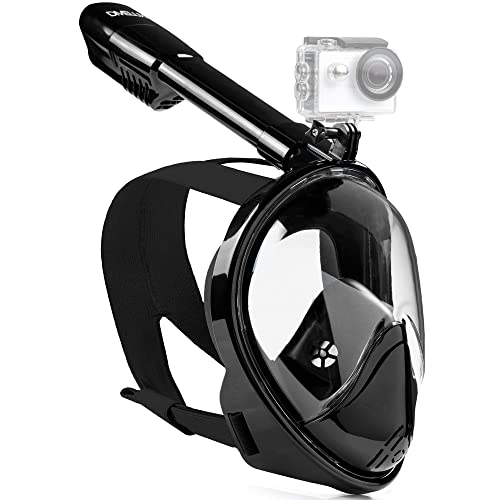With how popular full face snorkel masks have gotten over the last few years, manufacturers have made many tweaks to the original design to cater to their growing customer base.
Now, within the category of full face masks, there are subcategories such as masks with the snorkel located on the top or side of the mask, kid’s versions of adult snorkel masks, and the focus of this article: flat or curved lenses.
Since more people are buying full face masks, they are starting to question what all these fancy new features do. Are they just a marketing gimmick, or do they actually provide a meaningful benefit?
For the most part, full face mask designs have many similarities: similar colors, snorkel length, materials, and so on. However, one often overlooked factor is whether the lens is flat or curved, which can affect the view you get when you look through it. Flat lenses give you a more accurate view of reality, whereas curved lenses will warp the subject you’re looking at.
Seeing as how the snorkeling experience is largely affected by the view you are getting, the mask lens should actually be one of your top priorities if you want to get the nicest views.
In this article, we will go over the pros and cons of both flat and curved lens full face masks to help you better understand what you’re buying.
How to distinguish between flat and curved masks

First off, the difference between flat and curved masks are not as obvious as you might think, since even flat lenses have some curves on them.
If you’re not exactly sure what you’re looking at, here’s how you can tell if a full face mask is flat or curved.
For a flat lens full face mask, the center area in the front has a flat section. The sides of the lens will still be curved so that you still have some peripheral vision instead of nothing.
The flat lens design resembles a traditional scuba mask, with the addition of more transparent glass or plastic around the lens to cover your entire face.
As for a curved lens full face mask, the entire lens is curved all the way around, even at the front. In essence, it’s sort of like a dome shape, similar to an astronaut’s helmet lens.
Nowadays, manufacturers are starting to off their masks in flat or curved lens designs. Given the option to select one or the other, many consumers are starting to ask: which one is better? Are there any significant differences, or does it not really matter?
Similarities and differences
The biggest difference you’ll experience between these two lens designs is in the view you get. Both lenses will have some amount of distortion. However, one only has distortion around the edge, and the other has a distortion across the whole viewing area.
Flat lens
Were you able to guess which lens was which based on our description above?
The flat lens snorkel mask is the one which only has a small amount of distortion along the edges where it’s curved. However, thanks to the flat section in the front, the majority of what you’re seeing should be accurate to how it’s supposed to look.
Even a flat lens design has a curved edge, however, so that it still provides peripheral vision instead of being blocked off by a piece of plastic. That said, if you were to focus your vision on the crease of the mask, you will notice some distortion there, which can be disorienting. Best to simply look through the frontal flat section for the most accurate image.
If you’re someone that likes to rely on peripheral vision a lot, whether you go with a flat lens or curved lens design, you will experience some distortion with the side view.
Some people are disoriented regardless because they are not used to a part of their vision being distorted, even if it’s only from the side. However, it’s something that you will quickly get used to.
Some examples of full face snorkel masks with a flat lens design are the Subea Easybreath or the Wildhorn Outfitters 180 masks.
Curved lens
With a curved lens full face mask, the view you get through the mask lens will be slightly distorted even from the front, and even more distorted on the side.
If you’re having trouble picturing what it’s like, you can somewhat simulate this with your phone’s camera filter. Look for something called a “fisheye lens” filter and you can kind of get an idea of what it’s like to use a curved lens mask. Or you can just search Google images for some examples.
Keep in mind, the distortion in a curved lens mask is probably not as severe as a fisheye lens camera filter is, but there will be some warping of the image.
A common complaint that snorkelers have with the curved lens is that they don’t like how warped the view they are getting through the lens is.
Some people might even find it too disorienting, causing them to get headaches and feel the urge to vomit. Others have simply gotten used to the curved nature of the lens and find it to be a non-issue.
A popular example of a curved lens design is the Divelux Full Face Snorkel Mask.
Which design should I go with?

Knowing that curved lenses can cause you to feel nauseated sounds like a major downside, so why would someone want to pick a curved lens over a flat lens full face mask?
One factor might be aesthetics – not everyone likes how blocky the flat lens mask looks and prefer a smoother design with less sharp edges.
Another factor is consistency – they would rather see an image that is consistently warped than one that looks true accurate only in the middle section but is distorted along the edges.
Plus, the distortion along the crease of a flat lens mask can also be disorienting if you look through it, so it’s not like disorientation is a problem exclusive to a curved lens either.
Besides, it’s hard to claim one lens type is better than the other when the question will result in very subjective answers.
Unfortunately, at the end of the day, you will not know which one you prefer until you’ve tried on both masks and have a chance to form your own opinion.
For the most part, the general consensus seems to be that the flat lens design is preferred as long as you keep your eyes focused and looking through the flat section of the mask for an accurate view of the subject you’re looking at.
Curved lenses have too high of a risk of causing nausea due to the warped image you will see. Plus, the warped image makes it very difficult to take pictures while snorkeling, so if you plan to do that, the flat lens mask is the superior option.
At the end of the day, you need to pick a mask that is high quality. As important as the lens design is, it’s secondary to your safety and comfort. Cheap knock-off products may fit improperly, resulting in water leaks, fogging, or the snorkel getting clogged which are bigger issues to worry about.
Last update on 2024-11-19 / Affiliate links / Images from Amazon Product Advertising API



